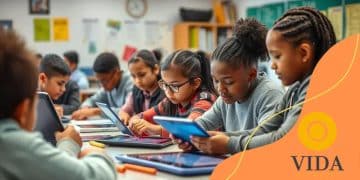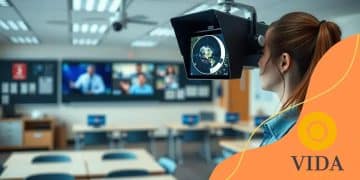Gaming used as a learning tool in K-12 education

Gaming used as a learning tool in K-12 education enhances student engagement, improves cognitive skills, facilitates collaboration, and prepares students for future challenges through innovative technology and personalized learning experiences.
Gaming used as a learning tool in K-12 education is reshaping the way students engage with learning.
Have you noticed how games can spark interest in subjects? This article dives into the remarkable ways that gaming can transform traditional education.
Benefits of gaming in K-12 education
Engaging students in K-12 education can be challenging, but gaming offers exciting benefits that enhance learning experiences.
It helps make lessons more enjoyable while promoting deeper understanding of complex topics.
Increased Motivation
One of the main benefits of gaming in education is the increase in student motivation. When students play games, they are encouraged to participate actively and stay focused.
This can lead to improved concentration and better retention of information.
Enhanced Problem-Solving Skills
Many educational games require learners to think critically and solve problems. This type of engagement fosters essential skills needed both in school and in real-life situations.
- Games promote strategic thinking.
- Students learn to analyze situations.
- Problem-solving skills emerge as they face challenges.
Moreover, students often collaborate when playing multiplayer games. This teamwork facilitates communication and social skills, enabling them to work effectively with others.
Real-Time Feedback
Another advantage of gaming for learning is the provision of immediate feedback. In traditional settings, students may have to wait for assessments to know how they are doing. In contrast, games provide instant evaluations that help learners identify areas for improvement.
- Feedback helps students adjust their strategies.
- It supports self-reflection and self-assessment.
- Continuous feedback leads to enhanced learning outcomes.
This quick turnaround fosters a growth mindset, as players understand that errors are part of the learning process.
Personalized Learning Experiences
Additionally, gaming allows for customized and personalized learning experiences. Different games can cater to various learning styles and paces.
Students can advance at their own rate, ensuring they grasp each concept before moving on.
Ultimately, the integration of gaming in K-12 education can lead to more engaging and effective learning.
With its myriad benefits, it is no wonder that educators are looking to incorporate it into their classrooms.
How games enhance cognitive skills

Games are not just for entertainment; they can significantly enhance cognitive skills in students. These skills are essential for academic success and everyday problem-solving.
Improving Memory
Many games involve remembering patterns, sequences, and details, which helps to strengthen memory.
When students engage in games, they can improve both short-term and long-term memory through repetition and practice.
- Memory games boost recall abilities.
- Players learn to remember important information.
- Stronger memory aids in classroom learning.
As students play, they often need to recall what they learned previously, making memory enhancement a vital aspect of gaming.
Enhancing Attention and Focus
Playing games requires players to concentrate and pay attention to various elements on the screen.
This increased focus can translate to better concentration during school activities. When students play games that challenge their attention, they often become more adept at staying on task.
- Games encourage persistent focus on objectives.
- Improved attention spans lead to better learning outcomes.
- Players learn to filter distractions effectively.
This engagement fosters a willingness to concentrate longer, which is crucial in the classroom environment.
Boosting Problem-Solving Skills
Many educational games present challenges that require critical thinking and strategic planning. As students navigate these challenges, they develop their problem-solving skills and learn to think creatively to find solutions.
Games often require players to make quick decisions and evaluate different strategies. This not only sharpens their analytical skills but also prepares them for real-life scenarios.
As students progress through levels, they face increasingly complex problems that help refine their cognitive abilities.
Engagement through gamified learning
Gamified learning is an exciting way to keep students engaged. By incorporating elements of games into educational settings, teachers can create an environment that motivates students to participate actively.
Active Participation
When learning is gamified, students are often more willing to engage with the material. They enjoy the challenge and the interactive nature of the activities.
This encourages them to take ownership of their learning.
- Students participate more willingly in lessons.
- Games foster interaction among peers.
- Students display a greater interest in the subject matter.
Through gamified approaches, students can share their progress and celebrate achievements, which can further enhance their enthusiasm.
Rewards and Incentives
Another key aspect of gamified learning is the use of rewards. When students earn points, badges, or other forms of recognition, they are motivated to continue striving for success.
This recognition can play a significant role in maintaining their interest in the material.
- Rewards encourage continued effort in learning.
- Students strive to complete challenges for recognition.
- Positive reinforcement boosts self-esteem.
As they receive rewards, students feel a sense of accomplishment, encouraging them to tackle more difficult tasks.
Collaboration and Teamwork
Gamified learning often promotes collaboration. Students frequently work together to overcome challenges or reach goals.
This teamwork not only fosters friendships but also builds essential social skills.
As they collaborate, students learn how to communicate effectively, share ideas, and support one another.
These skills are invaluable both in school and in their future careers.
Challenges in integrating gaming into curriculum
Integrating gaming into the curriculum can offer many benefits, but it also comes with its own set of challenges.
Addressing these obstacles is essential for successful implementation in K-12 education.
Resource Limitations
One significant challenge schools face is the lack of resources. Not all schools have the budget to purchase educational games or the necessary technology. Limited access to devices can hinder students from experiencing the advantages of gaming in their learning.
- Funding for games can be difficult to secure.
- Not all students may have access to technology at home.
- Some schools may lack the necessary infrastructure.
Without adequate resources, teachers may struggle to effectively integrate gaming into their lessons, reducing its overall impact.
Teacher Training
Another challenge is the need for teacher training. Many educators may not be familiar with using games in the classroom.
This lack of knowledge can lead to a reluctance to incorporate gaming into their teaching methods.
- Teachers might feel uncomfortable with technology.
- Professional development in gaming strategies is often lacking.
- Training can take time that educators may not have.
When teachers receive the proper support and training, they can more confidently use gaming to enhance their lessons.
Curriculum Alignment
Aligning games with the existing curriculum can also pose a challenge. Not every game fits seamlessly into lesson plans or state standards.
Finding high-quality educational games that align with learning objectives can be a time-consuming process.
This misalignment can lead to frustration and hinder the effectiveness of the educational experience. Teachers need to ensure that the games they select reinforce the concepts being taught.
Future trends of gaming in education
The future of gaming in education looks bright as technology continues to advance. More schools are beginning to recognize the value of incorporating games into the learning process. This integration can lead to more interactive and engaging classrooms.
Increased Use of Virtual Reality
One emerging trend is the use of virtual reality (VR) in educational settings. VR can transport students to different worlds and experiences that enhance their understanding of subjects. Imagine students exploring the solar system or walking through historic sites as part of their lessons.
- VR can provide immersive learning experiences.
- Students can visualize concepts more effectively.
- It allows for experiential learning without leaving the classroom.
This technology offers new ways to engage learners and can make subjects come alive.
Personalized Learning Experiences
The future will also see an increase in personalized learning through gaming. Adaptive games can tailor challenges based on individual student performance.
This means that each student can learn at their own pace and get the support they need.
- Personalized feedback helps students improve.
- Games can adapt to different learning styles.
- Students engage more when the material matches their needs.
As a result, learners can experience more effective educational journeys.
Collaboration Beyond Borders
Another exciting trend is the potential for global collaboration through gaming.
Students from different parts of the world can work together in online games, solving problems and completing tasks. This fosters cultural exchange and teamwork among young learners.
Global gaming platforms can help students build connections and friendships beyond their local environments, preparing them for a more interconnected world.
FAQ – Frequently Asked Questions about Gaming in K-12 Education
How does gaming help with student engagement in learning?
Gaming captures students’ interest, making lessons more interactive and fun, which encourages active participation.
What cognitive skills can be enhanced through educational games?
Educational games can improve memory, attention, and problem-solving skills, benefiting students academically.
What challenges do schools face when integrating gaming into the curriculum?
Schools often struggle with resource limitations, the need for teacher training, and aligning games with existing curriculum standards.
What future trends can we expect in gaming for education?
We can anticipate more use of virtual reality, personalized learning experiences, and global collaboration among students through gaming.






